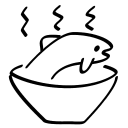KanjiPad - Japanese Handwriting recognition
KanjiPad is a simple (but snazzy) program which does Japanese handwriting recognition. It is uses the GTK toolkit for a GUI and Todd David Rudicks's algorithms from JavaDict for recognition.
Demo
A demo of KanjiPad in action.
Download
- kanjipad-2.0.0.tar.gz (about 76k)
- RPM for Red Hat 7.3, x86 (about 43k)
- Source RPM (about 79k)
- kanjipad-1.2.3.tar.gz (GTK+-1.2 based, about 77k)
- ChangeLog
KanjiPad requires the GTK toolkit (2.0.0 or later), available from:
From the README
KanjiPad -------- KanjiPad is a very simple program for handwriting recognition - The user draws a character into the box, then requests translation. The best candidates are displayed along the right hand side of the window and can be selected for pasting into other programs. It is meant primarily for dictionary purposes for learners of Japanese - it does not support entering kana, so it's usefulness as an input method is limited. Furthermore, if you already know the reading of a character, conventional pronunciation based methods of entering the character are probably faster. The handwriting recognition algorithms were invented by Todd David Rudick for his program JavaDict: http://www.cs.arizona.edu/japan/JavaDict/ and translated into C by Robert Wells for his program JStroke: http://www.wellscs.com/pilot/ JStroke runs on Pilot handheld computers. The contents of the jstroke/ subdirectory are from the JStroke distribution. KanjiPad works fine with a mouse. However, drawing characters is faster, more accurate, and more fun with a graphics tablet. (I use the Wacom Artpad II, available for about US $110.00) For more information about using graphics tablets with X Windows, see the XInput HOWTO at: http://www.gtk.org/~otaylor/xinput/XInput-HOWTO.html Availability ------------ The latest version of KanjiPad is available from http://fishsoup.net/software/kanjipad/ Prerequisites ------------- KanjiPad uses the GTK+ toolkit, version 2.0; it's been mostly developed on Unix and Linux, but with version 2.0 of GTK+, it can also be used on Microsoft Windows. GTK is available from: ftp://ftp.gtk.org/ Information about GTK+ on Win32 is available at: http://www.gimp.org/~tml/gimp/win32/ Note that you'll need the GTK+-2.0 packages, not the GTK+-1.3.0 version. Perl is also required to build the file 'jdata.dat'. Information about perl is available from http://www.perl.com GNU make is required for building KanjiPad. You probably already have this installed, but if not, you can get it from: http://www.gnu.org/software/make/ Installation ------------ * Make sure that pkg-config is in your path, and if you installed GTK+ in a different prefix than pkg-config, that PKG_CONFIG_PATH includes /prefix/of/gtk/lib/pkgconfig. * Edit the makefile and check that BINDIR and LIBDIR are set to the location where you want to install KanjiPad. * Build the program make [ Become root if necessary ] make install Use --- Draw your character into the large box, and click on "弟" (The upper button, abbreviating "look up") The use of Japanese abbreviations is for space reasons. I may eventually replace them with graphical icons. The characters used were picked rather casually. If you know of better characters to use for these purposes, please let know. Candidates will appear in the box to the right of the main area. Click on the desired character to select it for pasting into other programs. (Typically, pasting the selection is done in X by clicking the center mouse button.) To clear and start over, click on "消" (The lower button, abbreviating "clear") To quit select "Close" in the file menu. "Save" in the character menu will write out the points in the character, and the selected character to a file "samples.dat" in the current directory. This is intended for making a file of characters for automated testing. If "Annotate" in the character menu is selected, the strokes will be annotated with their order. License ------- KanjiPad is Copyright 1997-1999, 2002 Owen Taylor, and licensed under the terms of the GNU Public License. See the file COPYING for details. See the file jstroke/readme.txt for information about the license and copyright of JStroke. Owen Taylor October 27, 1997 March 19, 1999 [ update for GTK+-1.2 ] August 25, 2002 [ update for GTK+-2.0 ]
